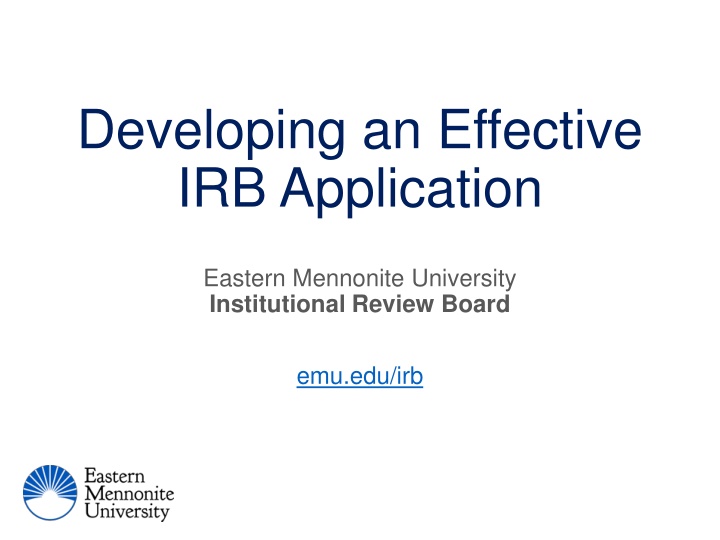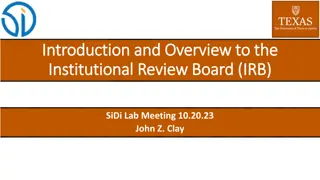Developing an Effective IRB Application
This informative content explores the historical origins of Institutional Review Boards (IRB), the three primary values researchers must uphold, qualifications required to conduct research, and the IRB process at Eastern Mennonite University. It delves into the importance of ethics, respect, and justice in research practices, emphasizing the protection of participants and the promotion of beneficial research outcomes.
Download Presentation

Please find below an Image/Link to download the presentation.
The content on the website is provided AS IS for your information and personal use only. It may not be sold, licensed, or shared on other websites without obtaining consent from the author.If you encounter any issues during the download, it is possible that the publisher has removed the file from their server.
You are allowed to download the files provided on this website for personal or commercial use, subject to the condition that they are used lawfully. All files are the property of their respective owners.
The content on the website is provided AS IS for your information and personal use only. It may not be sold, licensed, or shared on other websites without obtaining consent from the author.
E N D
Presentation Transcript
Developing an Effective IRB Application Eastern Mennonite University Institutional Review Board emu.edu/irb
Historical Origins The need for Institutional Review Boards (IRB) and for the proposal and review process arises from historical abuses in research some of which include: Nuremberg trials: revealed inhumane medical experimentation by WWII doctors :Gives rise to the Nuremberg Code of 1945 Declaration of Helsinki: in 1964 addressed the spread of biomedical research Tuskegee Syphilis Study, 1972: Disclosure of 30-year government-supported syphilis research (300 black men diagnosed with syphilis went untreated, told they had bad blood ) Prompted public Law 93-348 calling for the National Commission for Protection of Human Subjects of Biomedical and Behavioral Research
Three Primary Values Current code is based on the Belmont report that outlines three primary values that all researchers are asked to consider: Beneficence: maximize benefits for science and humanity while minimizing and avoiding harm Respect: aims to protect the autonomy and privacy rights of participants Justice: ensures that the cost of research does not burden one group more than another and that the benefits of research are not given heavily to one over group over others.
Qualifications to Conduct Research All researchers must demonstrate their qualification to conduct research by completing a national exam sponsored by the National Institutes of Health Find a link at www.emu.edu/irb The test is comprised of the following sections: Codes & Regulations (6 questions) Respect for Persons (6) Beneficence (5) Justice (4) At the end of your exam, you will receive a certificate that you will download onto your computer; valid for 4 years
IRB Process 1 SUBMIT your IRB proposal before you begin your research and at least one week before the scheduled full meeting of the board REVIEW - One member of the board reviews all submissions and separates the expedited reviews from those that need a full board review Expedited proposals are reviewed upon receipt and an immediate response is given Those that require a full review are forwarded to the full board for review at the next meeting (See schedule) APPROVAL - The board either approves the study as is or asks for clarifications or even modifications to the study if it is deemed important to assure the safety and well-being of the potential participants 2 3
Three Categories of Research Your first step is to go to the decision tree and discover which category your research falls into Remember, it is your IRB committee that will decide if your research should be expedited or will be reviewed fully by the board 1. Full board review 2. Expedited review 3. Classroom research Link: IRB Proposal Decision Tree emu.edu/irb/irb-proposal-decision-tree/
The Proposal Let s take a look at the elements of the proposal before we explore how to approach each. Remember that the submission link for students and for faculty are different; be sure you have identified the correct submission page! Link: Student Proposal Form emu.edu/irb/proposal/student/
How do I write a great proposal on my first attempt? Description of research and the purpose: Include why the research is important. If you are using a vulnerable population it would be important to describe this carefully This section guards against frivolous or burdensome research; what gap does your research fill in the literature, for example Method (Participants): Clearly describes who will participate How many participants do you hope to include? How will you recruit these participants? Will you screen participants and how?
Strong proposals, continued Identify Vulnerable Groups Remember that each vulnerable group has particular needs that will need to be considered Prisoners or Institutionalized persons Pregnant women/fetuses Children under 18 (educational settings with typical educational approaches do NOT constitute special populations) Seriously ill or persons with disabilities Etc. Make a careful estimate of the time that will be required of your participants
Informed Consent Describe how you will inform your participants about the purpose and procedures of the study Describe how you will assess participant understanding of their rights and of the process and purpose of the research Participants must be give consent to be photographed, video-taped or audio-taped whether or not you intend to share these in a presentation Outline how you will secure these recordings Include contact for the EMU IRB Board Upload your drafted informed consent Give careful attention to your informed consent form; it is one area that often delays approval! Link: Informed Consent Template emu.edu/irb/consent/
Describing Risks Risks include physical or emotional consequences to the participant as a result of participation, examples might include: Sadness, anger or other types of emotional distress upon reflection on research topic Physical discomfort from participation in the study Potential risk to health Impact of deception incorporated into research design Etc. If you identify a risk, please also specifically identify how you will address any adverse consequences, examples might include: A list of local counselors will be provided to those who participate and those who show distress will be encouraged to contact a counselor
Describe Benefits This section serves to assure that benefits don t unduly influence vulnerable persons to participate (e.g., offering a significant amount of money to the poor in order to entice their participation in high-risk medical experiments) Describe any benefits to your participant, examples: Gift cards Monetary payment Etc.
Reporting Results You are asked to describe how and to whom your results will be reported. List: Journal, newsletter, other print materials Professional conferences Classroom presentation Remember, your ability to share your results is limited to what is described in your proposal if you only include classroom presentation, you will have to write an additional proposal if you later want to present at a conference, for example.
Anonymity & Confidentiality Describe how you will maintain confidentiality and/or anonymity Will you provide pseudonyms and change identifying information (qualitative), for example? How will you secure your data? Data should be password protected or encrypted Consider maintaining health related research data in HIPPA compliant forms (encrypted, not stored on a Google drive)
Method: Procedure & Apparatus Method (Procedures): Describes how you will conduct your research, the procedures of your research & collection of data, and how the data will be processed Method (Apparatus): Describe all instruments or equipment you plan to use: Camera Video recorders Audio-recorders Survey instruments Attach any researcher-created instruments Qualitative studies that include an interview should include your proposed questions
Common Problems that Can Delay Approval 1. Remember to attach your NIH certificate 2. Remember your faculty approval form and don t forget to attach one that is signed 3. Carefully review your consent form. Does it fully and completely inform your client about what is being asked of them and potential risks & benefits? 4. Have you included EMU IRB contact information? 5. Have you attached your consent? 6. Fully describe how you will protect your data & participant confidentiality 7. Have you attached any surveys or researcher created interviews?























